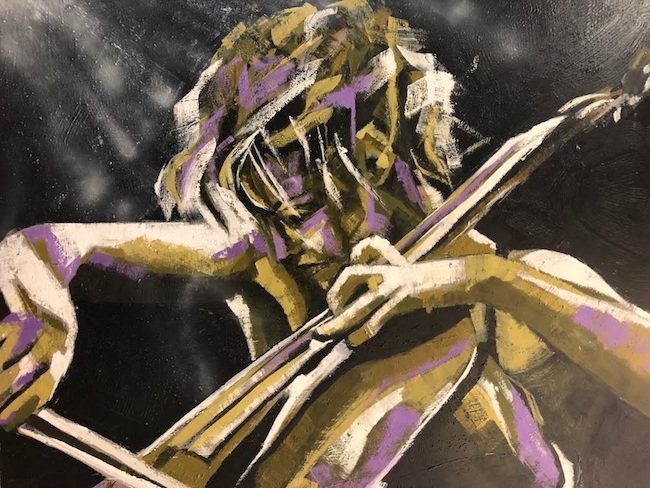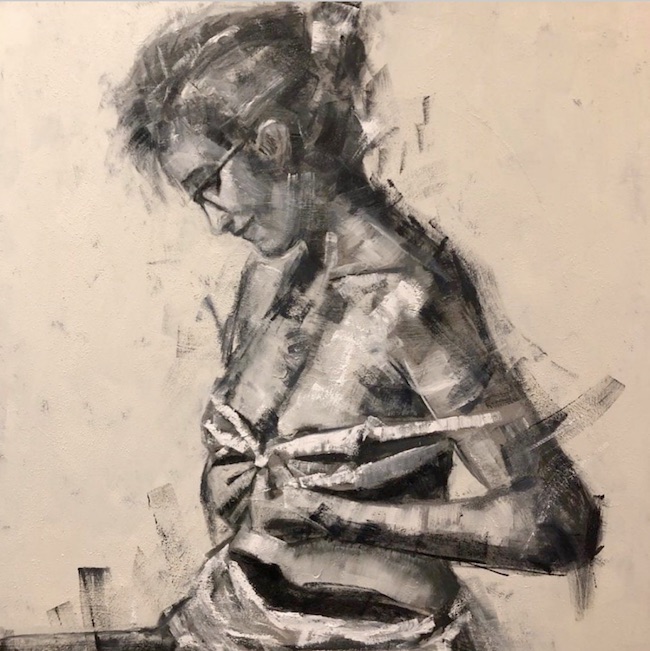Nell’arte di tutti i tempi la figura femminile ha costituito un’icona, l’immagine prediletta da molti artisti per essere immortalata, raccontata e idealizza in tutte le sue sfumature; molto spesso sublimata, altre compresa solo in una parte della sua essenza, altre interpretata senza svelarne il reale mistero. Esistono nella contemporaneità artiste che sentono la necessità di raccontare le sfaccettature delle donne senza renderle migliori, senza evidenziarne la bellezza oggettiva, bensì ponendo l’accento sulle loro emozioni, sulla forza, sull’istinto e sulla determinazione che le contraddistingue. La protagonista di oggi sceglie esattamente questa strada, il cammino verso l’esplorazione e la conoscenza di sé attraverso la narrazione delle sensazioni dei suoi personaggi.
Rappresentata come madre, come simbolo di purezza, come icona irraggiungibile oppure, al contrario, come tentatrice in grado di annebbiare i sensi e la mente, la donna ha costantemente costituito quel mistero mai risolto agli occhi degli artisti di ogni secolo, prevalentemente uomini fino alla prima metà del Novecento, che non hanno mai saputo entrare nell’interiorità delle figure immortalate proprio in virtù delle profonde differenze tra Yin e Yang, tra l’emisfero femmineo e quello maschile, malgrado l’incredibile sensibilità descrittiva che molti autori avevano nel narrarne le sfumature. Mentre nei secoli precedenti l’approccio pittorico doveva attenersi alla realtà osservata dando prevalenza alla perfezione plastica, all’estetica piuttosto che all’esplorazione interiore, a partire da fine Ottocento cominciò a delinearsi quella rivoluzione artistica preannunciata dai Fauves e concretizzatasi poi con l’Espressionismo, in antitesi al mantenimento e all’attinenza alla bellezza dell’Impressionismo che pure teorizzò una cifra pittorica inedita e contraddistinta dalla scomposizione dell’immagine, decretando la predominanza del sentire sul vedere, dell’emozionare sul rappresentare. Da quel momento in avanti il mondo interiore condusse gli artisti ad un’attenzione diversa nei confronti dei moti più profondi dell’animo, in particolar modo di quello femminile, immortalato nelle sue diverse manifestazioni, e dunque l’aura ideale che aveva contraddistinto opere eterne e celeberrime come la Venere del Botticelli, la Monna Lisa di Leonardo da Vinci, la Ragazza con l’orecchino di perla di Jan Vermeer, cominciò a lasciare posto alla sensualità, alla dissolutezza oppure alla pura apparenza di dipinti immortali come Giuditta I di Gustav Klimt, l’erotismo dei nudi femminili dell’espressionista Egon Schiele, o le icone modaiole, patinate ed eleganti di Tamara de Lempicka. Il Ventesimo secolo coincise anche con l’accesso all’espressione artistica da parte delle donne, svelando un punto di vista differente sulla femminilità osservata e raccontata dalla capacità empatica ed espressiva di grandi pittrici come Frida Khalo, di Natal’ja Sergeevna Gončarova, di Marlene Dumas in cui l’interiorità doveva prevalere e fuoriuscire su ogni modello estetico. L’artista romana Stefania Catenacci, in arte Cate, riprende le pennellate fugaci e piatte della Gončarova dando loro un aspetto più squadrato, quasi accennando un principio di intento cubista solo per enfatizzare le sfaccettature dell’essenza, quei veri colori che fuoriescono solo a fronte di un attento ed empatico ascolto.
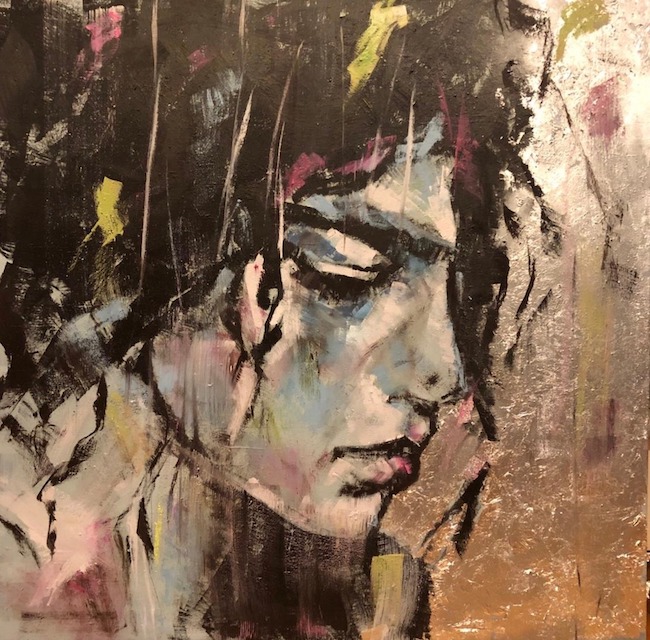
Il mondo della fotografia, parte della sua formazione professionale, entra nei dipinti attraverso la capacità di riprodurre un frangente, un istante oltre il quale tutto sarebbe diverso, persino la sensazione percepita dall’artista subirebbe una modificazione che renderebbe un momento diverso da quello del frangente precedente.
Dunque l’intensità figurativa, l’aderenza alla realtà osservata viene mescolata, quasi confusa dai tocchi brevi e rapidi di colore che sono funzionali a lasciar trapelare tutto ciò che dall’immagine non riuscirebbe a fuoriuscire. Sono donne forti, energiche, passionali, ribelli le protagoniste di Stefania Catenacci, simboli della consapevolezza raggiunta nel Ventunesimo secolo, di quella libertà di esprimersi e di essere se stesse malgrado tutto, a dispetto delle regole, contro ogni barriera che la vita e la società tende ancora a porre davanti al loro cammino.
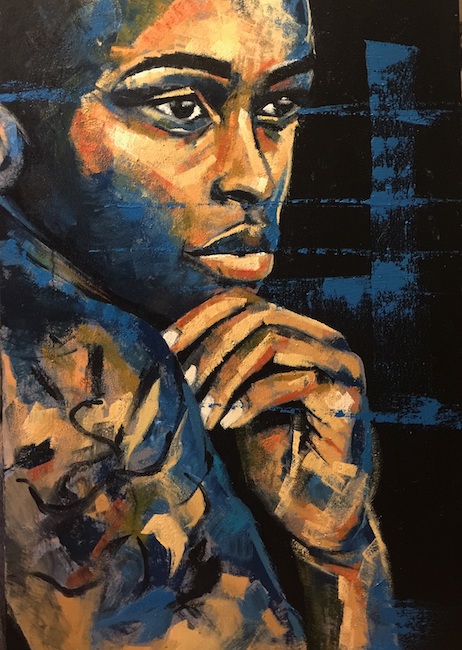
L’istinto, l’impulso, viene così inteso come motore propulsivo, come elemento positivo volto al raggiungimento di un equilibrio interiore in virtù del quale esprimere le proprie pulsioni, i propri desideri e i propri sogni, tanto quanto le emozioni più spiacevoli, non è più un limite, non si amalgama più al timore di non essere accettata nella sua interezza.
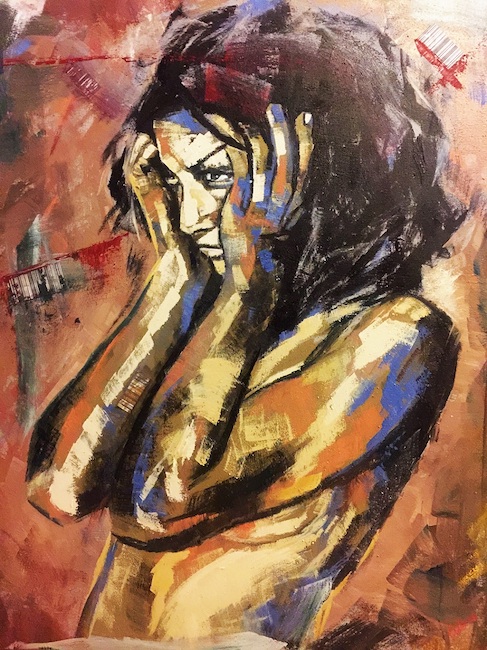
Nella tela Codici a barre il concetto è fortemente amplificato poiché l’espressione della ragazza, sola con se stessa e dunque spogliata dai filtri che abitualmente vengono posti con il mondo esterno, racconta di un istante di incredulità mista a rabbia, per qualcosa che ha visto verificarsi e su cui non è potuta intervenire per modificarne l’epilogo, oppure il suo atteggiamento è di pentimento per una sua azione che ha dato il via a un concatenamento di eventi a seguito dei quali nulla sarà più come prima. Il corpo nudo sta a rappresentare la necessità di osservare se stessa con sguardo sincero, senza maschere, senza filtri, per andare a scoprire le sensazioni più genuine, quella girandola emozionale che la Catenacci racconta attraverso tonalità irreali eppure profondamente legate all’interiorità della donna.
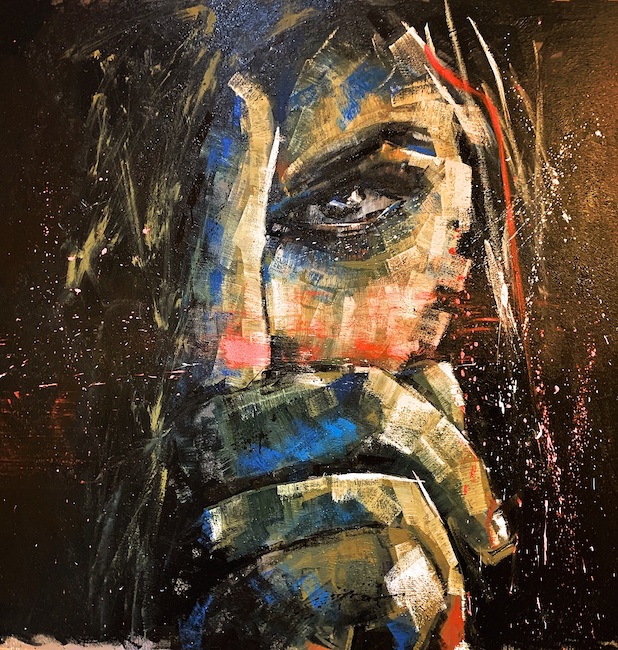
In Stop ciò che emerge è la determinazione, la ferma decisione che un evento non si verifichi ancora, che qualcosa che è sopraggiunto a turbare l’esistenza della protagonista mai più potrà né dovrà far parte della sua quotidianità; quest’opera si avvicina al tema della violenza sulla donna, ancora troppo presente nella cultura di molti popoli e che deve necessariamente essere arginata soprattutto da chi ne è vittima, per non concedere all’uomo di poter reiterare un comportamento ingiusto, crudele, inaccettabile. È questa la netta opposizione svelata dallo sguardo intenso della ragazza, descritta con l’ombra cupa di una parte del suo volto che però nell’altro lato, quello più consapevole di non voler subire ancora, si manifesta attraverso pennellate nervose, con tocchi di colore intensi come il rosso della rabbia e il blu della fredda risolutezza.
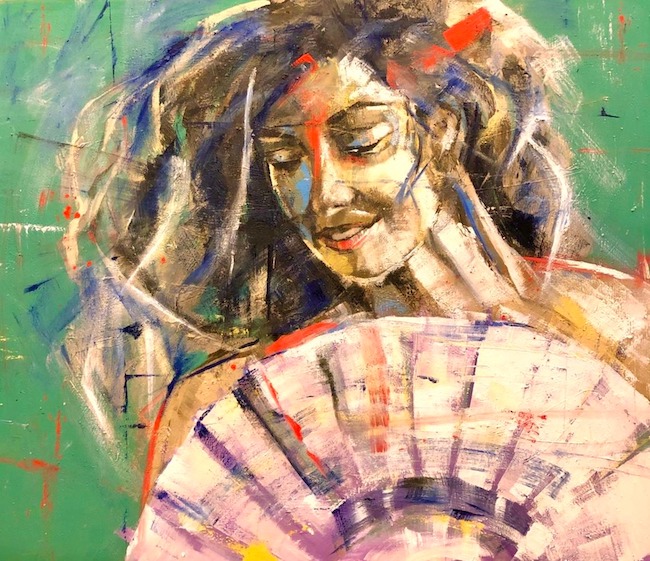
Nel momento in cui le sensazioni sono più piacevoli, leggere e delicate anche la gamma cromatica si modifica, lasciando spazio a colori pastello, in armonia gli uni con gli altri malgrado la gradazione differente, a sfumature morbide che rappresentano momenti di benessere come nella tela Sto bene così in cui Stefania Catenacci interpreta un frangente positivo, un istante sereno che rende la donna gioiosa e giocosa per aver compreso di non aver bisogno di altro se non di apprezzare ciò che ha; gioca con la semplicità l’artista in quest’opera, ponendo l’accento su quanto la società contemporanea si sia allontanata dall’abitudine a dare considerazione alla piacevolezza delle piccole cose, alla serenità di qualcosa di apparentemente banale eppure in grado di riempire l’esistenza se si riesce a guardare tutto dall’ottica giusta. Il ventaglio rappresenta quell’elemento modesto e facilmente accessibile che costituisce tutto ciò di cui la ragazza protagonista ha bisogno per sentirsi in pace con se stessa.
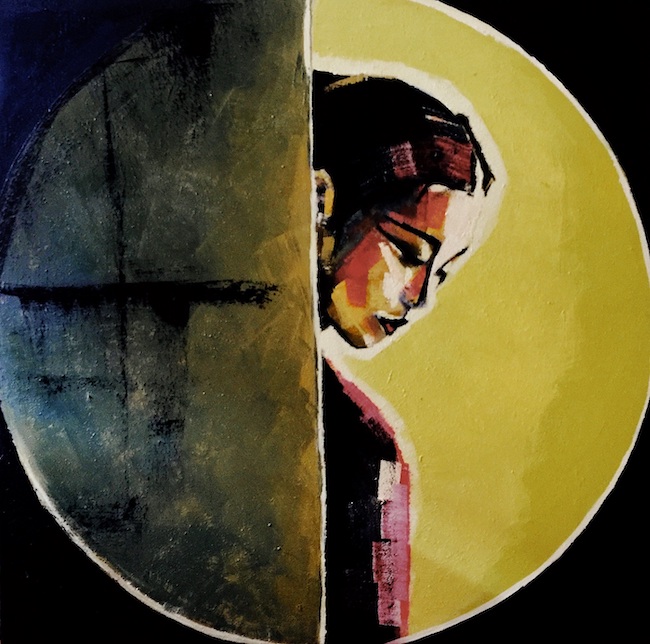
E ancora in Geisha l’artista sembra spiare un momento intimo della donna orientale protagonista, un attimo di riflessione e di contatto con il sé più profondo, un frangente nel quale pensa alla sua vita reale al di fuori dal mondo di immagine e di estetica che identifica le iconiche figure giapponesi. La sfera gialla rappresenta le luci e le ombre di un mondo profondo e silenzioso, spesso ignorato e altrettanto spesso incompreso e lasciato in secondo piano rispetto all’esigenza di mostrare il volto migliore, quello affascinante, ma anche vuoto, della pura forma esteriore. Di origini abruzzesi, nata e cresciuta a Roma, Stefania Catenacci ha partecipato nel corso della sua carriera a molte mostre collettive e personali sul territorio nazionale, è ospite alle mostre dei Cento Pittori di via Margutta e dal 2016 collabora con la Galleria Vittoria di via Margutta.
STEFANIA CATENACCI-CONTATTI
Email: steficatenacci@gmail.com
Facebook: https://www.facebook.com/Stefania-Catenacci-InarteCate-567643823306953
Instagram: https://www.instagram.com/inartecate/?hl=it
The woman with all her strength and energy in the artworks of Stefania Catenacci
In art throughout the ages, the female figure has been an icon, the favourite image of many artists to be immortalised, narrated and idealised in all its nuances; very often sublimated, others understood only in part of its essence, others interpreted without revealing its real mystery. There are contemporary artists who feel the need to tell the story of the facets of women without making them better, without highlighting their objective beauty, but rather by emphasising their emotions, strength, instinct and determination. Today’s protagonist chooses exactly this path, the path towards exploration and self-knowledge through the narration of her characters’ feelings.
Represented as a mother, as a symbol of purity, as an unattainable icon or, on the contrary, as a temptress capable of clouding the senses and the mind, women have always constituted that mystery never solved in the eyes of artists of every century, mainly men until the first half of the twentieth century, who have never been able to enter into the interiority of the figures immortalised precisely because of the profound differences between Yin and Yang, between the female and male hemispheres, despite the incredible descriptive sensitivity that many authors had in narrating their nuances. While in previous centuries the pictorial approach had to stick to observed reality, giving prevalence to plastic perfection and aesthetics rather than inner exploration, from the end of the nineteenth century started to outline that artistic revolution heralded by the Fauves and materialised with Expressionism, in contrast to the maintenance of and reference to the beauty of Impressionism which also theorised an unprecedented pictorial style marked by the decomposition of the image, decreeing the predominance of feeling over seeing, of emotions over representation. From that moment onwards, the inner world led artists to pay a different kind of attention to the deepest motions of the soul, especially the female soul, immortalised in its various manifestations, and thus the ideal aura that had distinguished eternal and famous works such as Botticelli’s Venus, Leonardo da Vinci’s Mona Lisa, Jan Vermeer’s Girl with a Pearl Earring, began to give way to the sensuality, debauchery or pure appearance of immortal paintings such as Gustav Klimt’s Judith I, the eroticism of the female nudes of expressionist Egon Schiele, or the fashionable, glossy and elegant icons of Tamara de Lempicka.
The twentieth century also coincided with women’s access to artistic expression, revealing a different point of view on femininity observed and recounted by the empathic and expressive capacity of great female painters such as Frida Khalo, Natal’ja Sergeevna Gončarova and Marlene Dumas, in whom interiority had to prevail and emerge from every aesthetic model. The Roman artist Stefania Catenacci, aka Cate, takes up Gončarova’s fleeting, flat brushstrokes, giving them a more squared-off look, almost hinting at a principle of cubist intent, just to emphasise the facets of the essence, those true colours that only come out after careful, empathetic listening. The world of photography, part of his professional training, enters into his paintings through his ability to reproduce a juncture, an instant beyond which everything would be different, even the sensation perceived by the artist would undergo a modification that would make a moment different from that of the previous juncture. Thus the figurative intensity, the adherence to the observed reality is mixed, almost confused by the short, rapid touches of colour that are used to reveal everything that would not be able to emerge from the image. Stefania Catenacci’s protagonists are strong, energetic, passionate, rebellious women, symbols of the awareness reached in the 21st century, of that freedom to express themselves and be themselves in spite of everything, in spite of the rules, against every barrier that life and society still tends to place in their path. Instinct, impulse, is thus understood as a propulsive engine, as a positive element aimed at achieving an inner balance by virtue of which expressing one’s impulses, desires and dreams, as much as the most unpleasant emotions, is no longer a limitation, no longer amalgamated with the fear of not being accepted in its entirety. In the painting Bar Codes the concept is strongly amplified because the expression of the girl, alone with herself and therefore stripped of the filters that are usually placed with the outside world, tells of an instant of incredulity mixed with rage, for something that she has seen happen and on which she has been unable to intervene to change the outcome, or her attitude is that of repentance for an action that has triggered a chain of events after which nothing will ever be the same again.
The naked body represents the need to observe oneself with a sincere gaze, without masks, without filters, in order to discover the most genuine sensations, that emotional whirlwind that Catenacci recounts through unreal tones that are nevertheless profoundly linked to the woman’s interiority. In Stop, what emerges is determination, the firm decision that an event will never happen again, that something that has come to disturb the protagonist’s existence can and must never again be part of her everyday life. This work approaches the theme of violence against women, which is still too present in the culture of many peoples and which must necessarily be contained, especially by those who are its victims, so as not to allow men to repeat an unjust, cruel and unacceptable behaviour. This is the stark opposition revealed by the girl’s intense gaze, described with the dark shadow of one side of her face, which, however, on the other side, the one most aware of not wanting to suffer any more, is manifested through nervous brushstrokes, with intense touches of colour such as the red of anger and the blue of cold resoluteness. When the sensations are more pleasant, light and delicate, the chromatic range also changes, leaving room for pastel colours, in harmony with each other despite the different gradation, for soft shades representing moments of wellbeing as in the canvas Sto bene così (I’m fine this way) in which Stefania Catenacci interprets a positive juncture, a serene moment that makes the woman joyful and playful because she has understood that she needs nothing more than to appreciate what she has; the artist plays with simplicity in this painting, emphasising how far contemporary society has moved away from the habit of giving consideration to the pleasantness of small things, to the serenity of something apparently trivial yet capable of filling existence if we manage to look at everything from the right angle.
The fan represents that modest and easily accessible element that constitutes all that the girl protagonist needs to feel at peace with herself. And again in Geisha the artist seems to spy on an intimate moment of the oriental woman protagonist, a moment of reflection and contact with her deepest self, a moment in which she thinks about her real life outside the world of image and aesthetics that identifies the iconic Japanese figures. The yellow sphere represents the lights and shadows of an deep and silent world, often ignored just as often misunderstood and left in the background compared to the need to show the best face, the fascinating but also empty face of pure external form. Of Abruzzese origings, born and raised in Rome, Stefania Catenacci has taken part in many group and solo exhibitions throughout her career. She is a guest at the exhibitions of the Cento Pittori di via Margutta and since 2016 she has been collaborating with Galleria Vittoria in via Margutta.


